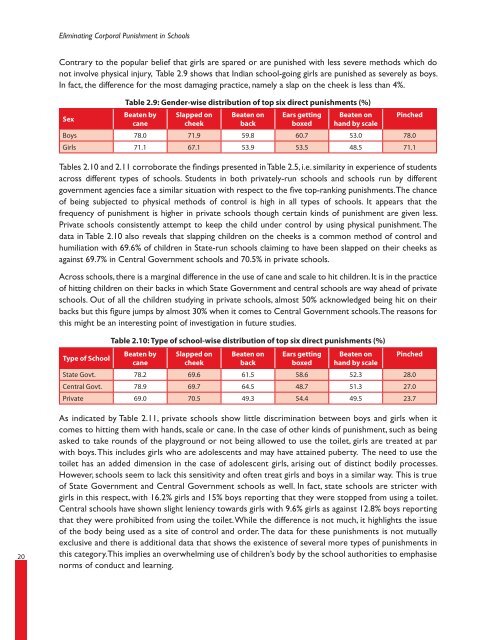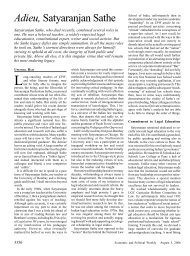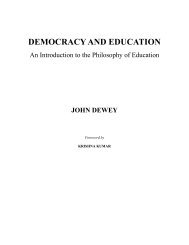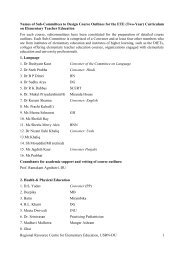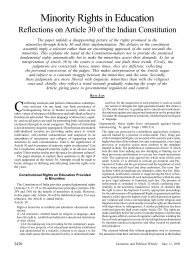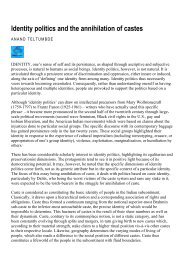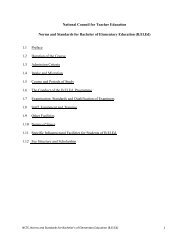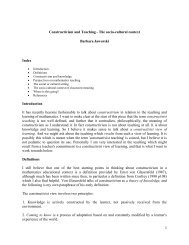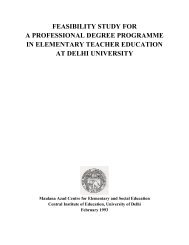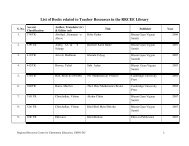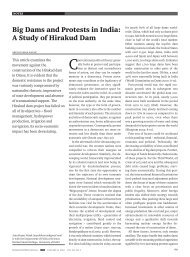Corporal Punishment - Eledu.net
Corporal Punishment - Eledu.net
Corporal Punishment - Eledu.net
You also want an ePaper? Increase the reach of your titles
YUMPU automatically turns print PDFs into web optimized ePapers that Google loves.
Eliminating <strong>Corporal</strong> <strong>Punishment</strong> in SchoolsContrary to the popular belief that girls are spared or are punished with less severe methods which donot involve physical injury, Table 2.9 shows that Indian school-going girls are punished as severely as boys.In fact, the difference for the most damaging practice, namely a slap on the cheek is less than 4%.SexTable 2.9: Gender-wise distribution of top six direct punishments (%)Beaten bycaneSlapped oncheekBeaten onbackEars gettingboxedBeaten onhand by scalePinchedBoys 78.0 71.9 59.8 60.7 53.0 78.0Girls 71.1 67.1 53.9 53.5 48.5 71.1Tables 2.10 and 2.11 corroborate the findings presented in Table 2.5, i.e. similarity in experience of studentsacross different types of schools. Students in both privately-run schools and schools run by differentgovernment agencies face a similar situation with respect to the five top-ranking punishments. The chanceof being subjected to physical methods of control is high in all types of schools. It appears that thefrequency of punishment is higher in private schools though certain kinds of punishment are given less.Private schools consistently attempt to keep the child under control by using physical punishment. Thedata in Table 2.10 also reveals that slapping children on the cheeks is a common method of control andhumiliation with 69.6% of children in State-run schools claiming to have been slapped on their cheeks asagainst 69.7% in Central Government schools and 70.5% in private schools.Across schools, there is a marginal difference in the use of cane and scale to hit children. It is in the practiceof hitting children on their backs in which State Government and central schools are way ahead of privateschools. Out of all the children studying in private schools, almost 50% acknowledged being hit on theirbacks but this figure jumps by almost 30% when it comes to Central Government schools. The reasons forthis might be an interesting point of investigation in future studies.Type of SchoolTable 2.10: Type of school-wise distribution of top six direct punishments (%)Beaten bycaneSlapped oncheekBeaten onbackEars gettingboxedBeaten onhand by scalePinchedState Govt. 78.2 69.6 61.5 58.6 52.3 28.0Central Govt. 78.9 69.7 64.5 48.7 51.3 27.0Private 69.0 70.5 49.3 54.4 49.5 23.720As indicated by Table 2.11, private schools show little discrimination between boys and girls when itcomes to hitting them with hands, scale or cane. In the case of other kinds of punishment, such as beingasked to take rounds of the playground or not being allowed to use the toilet, girls are treated at parwith boys. This includes girls who are adolescents and may have attained puberty. The need to use thetoilet has an added dimension in the case of adolescent girls, arising out of distinct bodily processes.However, schools seem to lack this sensitivity and often treat girls and boys in a similar way. This is trueof State Government and Central Government schools as well. In fact, state schools are stricter withgirls in this respect, with 16.2% girls and 15% boys reporting that they were stopped from using a toilet.Central schools have shown slight leniency towards girls with 9.6% girls as against 12.8% boys reportingthat they were prohibited from using the toilet. While the difference is not much, it highlights the issueof the body being used as a site of control and order. The data for these punishments is not mutuallyexclusive and there is additional data that shows the existence of several more types of punishments inthis category. This implies an overwhelming use of children’s body by the school authorities to emphasisenorms of conduct and learning.


